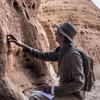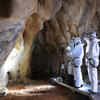You are here
The adventurers behind the lost Neanderthal
11.08.2024, by
After more than nine years of research at the Grotte Mandrin site in the Drôme, the archaeologist Ludovic Slimak and his team have confirmed that they have unearthed the remains of a Neanderthal, nicknamed Thorin. According to their study published in the journal Cell Genomics, Thorin lived a little over 40,000 years ago, and was in fact one of the last representatives of an older lineage. A look back at images from this discovery.
Reference "Long genetic and social isolation in Neanderthals before their extinction(link is external)", L. Slimak et al., Vol. 4, Issue 9, 100593, September 11, 2024.
Further viewing “Thorin, the last Neanderthal (in French) (link is external),” 54 minute documentary directed by Pascal Cuissot (Ludovic Slimak scientific advisor), Arte TV, available until 11 December 2024.

1
Slideshow mode
More than 40,000 years ago, Neanderthals no doubt looked out from Grotte Mandrin over the Rhône river valley, a major natural corridor for circulating between continental Europe and the Mediterranean. The team’s discovery that the site was occupied by a Neanderthal lineage–one that ultimately turned out to be highly isolated from the primary lineage–raises questions regarding the nature of these populations, their organisation, and their way of life.
Hubert Raguet / CAGT / CNRS Images

2
Slideshow mode
Ludovic Slimak has led missions from the Equator to the polar circle, but it was in the Drôme department of France that he made a major discovery in the mid-2010s. He and his team unearthed the remains of a Neanderthal that they nicknamed Thorin. In this image, the archaeologist uses his brush to point out a tooth, which is quite difficult to identify amid the thousands of human and animal bone fragments, as well as the large quantities of carved flint strewn about the floor.
Hubert Raguet / CAGT / CNRS Images

3
Slideshow mode
Located in the commune of Malataverne in the north of the Drôme, the Grotte Mandrin is a rock shelter containing numerous remains and fossils, and has been excavated continuously since 1990. The traces of human settlement, both Homo Sapiens and Neanderthal, stretch from -120,000 to -42,000 years ago.
Ludovic Slimak

4
Slideshow mode
Always wearing gloves, which prevent the samples from being contaminated by modern DNA, the scientists gradually unearthed bone fragments over the course of nine years, including phalanges, palate and skull parts, and teeth belonging to Thorin (pointed out by the finger at left, and shown in close-up at right).
Hubert Raguet / CAGT / CNRS Images ; © Ludovic Slimak

5
Slideshow mode
Their publication was featured on the cover of the journal Cell Genomics in September 2024, and presented an overview of the bones, including 31 teeth (at left) and 5 phalanges of the left hand (at right). These phalanges present traditionally well-known morphologies among Neanderthals, but also a certain slenderness for an individual of this species.
Xavier Muth / Ludovic Slimak – © Hubert Raguet / CAGT / CNRS Images

6
Slideshow mode
Thorin’s remains were found in a layer of sediment at the top of the archaeological sequence, as well as at the entrance to Grotte Mandrin. Here the co-author of the study, Xavier Muth, is using photogrammetry and tacheometry to digitise and map the soil and objects unearthed during the dig. The researchers take a series of high-definition pictures in order to create 3D models for both the site and for the archaeological “stripping” (gradual removal of layers of soil to observe what lies underneath).
Hubert Raguet / CAGT / CNRS Images

7
Slideshow mode
Once the photogrammetry effort is complete, the various resulting scans are combined, and the archaeological objects (human and animal bones, flint tools) are repositioned precisely as they were in the soil before excavation. In this 3D reconstruction, the fragments from Thorin’s body appear (in colour) crushed in the sandy sediment.
Xavier Muth / Ludovic Slimak

8
Slideshow mode
Back at the laboratory, some fossils are also digitised using photogrammetry, such as this canine from Thorin in the researcher’s hand (at left). Photogrammetry can provide an extremely accurate digital replica of each archaeological element unearthed at the site, and can reconstitute the Neanderthal’s dentition (at right).
Hubert Raguet / CAGT / CNRS Images ; © Clément Zanolli

9
Slideshow mode
To determine what Neanderthal lineage Thorin belonged to, Andaine Seguin-Orlando, a geneticist at l’université de Toulouse-Paul-Sabatier, is preparing samples of Thorin’s teeth in order to extract DNA from them. Genetic analysis revealed the discovery of a previously unknown population of late Neanderthals.
Arte France / Fred Hilgemann Films - 2024 / in « Thorin, le dernier Neandertalien », by Pascal Cuissot

10
Slideshow mode
After determining their use via microscopic analysis, Laure Metz uses traceology—a discipline that identifies the functioning of prehistoric objects—and technical drawing to very accurately reproduce the objects. Coupled with the vast body of experiments reproducing archaeological objects, these studies provide a fine-grained view of the domestic activities (cutting meat, working hides, etc.) and hunting activities practiced by these human groups.
Hubert Raguet / CAGT / CNRS Images

11
Slideshow mode
Slimak discussing with Clive Finlayson (at right), the director of archaeological research on the Neanderthal populations in Gibraltar, in the documentary Thorin: The Last Neanderthal. He is holding a skull found in Forbes’ Quarry during the nineteenth century. According to genetic analysis, both the skull and Thorin belonged to two representatives of the same population. The scientists thus formulated the hypothesis that a population of “older” Neanderthals was contemporary to the main lineage, and occupied parts of the coasts of the Western Mediterranean stretching from Spain to the Rhône valley. This shakes up our understanding of the last Neanderthal populations in Europe.
Arte France / Fred Hilgemann Films - 2024 / in « Thorin, le dernier Neandertalien », by Pascal Cuissot
Explore more
Society
Article
12/02/2025
Article
11/09/2025
Article
10/20/2025
Article
10/15/2025
Article
10/03/2025
Archaeology
Article
09/29/2025
Article
04/21/2025
Article
04/16/2025
Article
10/31/2024
Article
10/14/2024











